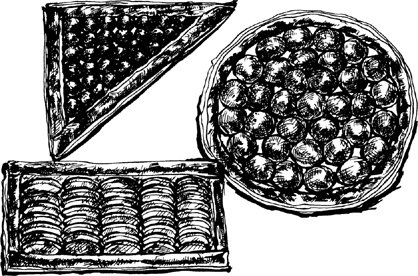Mastering the Art of French Cooking, Volume 2 (193 page)
Read Mastering the Art of French Cooking, Volume 2 Online
Authors: Julia Child

Remove from heat, and stir vigorously a moment or two to cool the sauce and stop the cooking. Rinse out mixing bowl, and strain the sauce into it.
4)
Filling the mold
A pan of boiling water large enough to hold dessert mold easily
About 1 pound of
brioche,
sponge cake, or store-bought sponge-type of cake
(Preheat oven to 350 degrees for next step.) Check water level of pan with mold set into it, and place pan (without mold) in lower-middle level of oven. Slice
brioche
or cake into 3 layers, each about ⅛ inch thick, and trim so they will fit into the mold exactly. (Each layer may consist of several pieces neatly fitted together.)
Fit a layer of cake in the bottom of the caramelized mold. Drain the raisins and sprinkle 3 tablespoons of their rum maceration over the cake. Arrange a row of
cherry halves (or mixed diced fruit) around the edge of the cake, and spread a third of the raisins and apricots (or more diced mixed fruit) over the rest of the cake. Pour in a third of the custard. Put down a second layer of cake, sprinkle with 3 tablespoons more rum, and continue filling the mold in layers. Leave about ¼ inch of unfilled space at top of mold because dessert will swell slightly during cooking. Cover remaining rum and reserve for flambéeing.
(*)
AHEAD-OF-TIME NOTE
: Mold may be filled a day in advance of baking; cover airtight and refrigerate. Chilled custard will probably take at least 20 minutes more to bake than the 45 to 60 minutes specified in Step 5.
5)
Baking the dessert—45 to 60 minutes at 350 degrees, plus a 10-minute rest (longer if custard has been chilled)
Place the filled mold in the pan of hot water in the oven (water should come ¾ the way up outside of mold). Bake for 45 minutes to 1 hour, regulating heat so that water in pan almost but never quite bubbles—to ensure a smooth and velvety texture to the custard. Add more boiling water, as necessary, if liquid drops below the halfway mark. Dessert is done when it begins to show a faint line of shrinkage from sides of mold.
If you wish to serve within 10 to 15 minutes, remove mold from water and allow custard to settle for 10 minutes before unmolding, Step 6; otherwise leave custard in its pan of water in turned-off oven. Dessert must be hot for successful flambéeing.
6)
Unmolding, flambéeing, and serving
A thin-bladed flexible knife for help in unmolding
A very hot, lightly buttered serving platter
3 or 4 broken sugar lumps and 1 Tb sugar
The remaining rum (at least ½ cup) in a small saucepan
Matches
A pair of long-handled serving utensils
The moment before serving, run knife around edge of mold, turn hot platter upside down over it, and reverse the two to unmold dessert onto platter. Stick the broken sugar lumps into the dessert at various places, and sprinkle on the plain sugar. Heat the rum and pour it over the dessert. Averting your face, ignite the rum with a lighted match, and bring the
charlotte
flaming to the table. Spoon flaming rum over the dessert as you begin to serve.
DESSERTS USING FRENCH PUFF PASTRY
French puff pastry, that unbelievably tender and buttery dough, with its hundreds of thinner-than-paper layers, is ideal for desserts. Because the pastry itself is so marvelous, the rest of the ingredients are usually rather simple and
easy to assemble. We give only a sampling of the many, many recipes that use
puff pastry, going into enough illustrated detail, we hope, so that when you run into other puff pastry recipes elsewhere, they will seem feasible and even familiar.
Your sole problem—which need be no problem at all—is to keep the dough cold while you are working on it. At the slightest suggestion of limpness, stop where you are, refrigerate everything for 15 to 20 minutes, then continue. If you are not yet used to working with puff pastry, do not attempt anything complicated in a hot kitchen; wait for cool weather or an air-conditioned atmosphere. Chilled dough in a cool room is easy to manipulate; soft, limp dough in a warm room is impossible.
ABAISSES EN FEUILLETAGE POUR TARTES AUX FRUITS
[Forming Puff Pastry
Shells for Fruit Tarts]
With French puff pastry you can make free-standing shells of any size and shape you wish: the sides of the pastry rise automatically in the oven while the bottom stays put, held down by the fruit or, if you wish a precooked shell, by a pan. Use either the
simple puff pastry
, or the reconstituted
leftover puff pastry
. We shall not give proportions, except to say that one fourth of the recipe, or a piece of dough 5¼ by 2 by 1¾ inches, will make a rectangular pastry 6 inches wide and 13 inches long, with a bottom layer ⅛ inch thick; thus half the recipe would make a 12- to 13-inch square.



